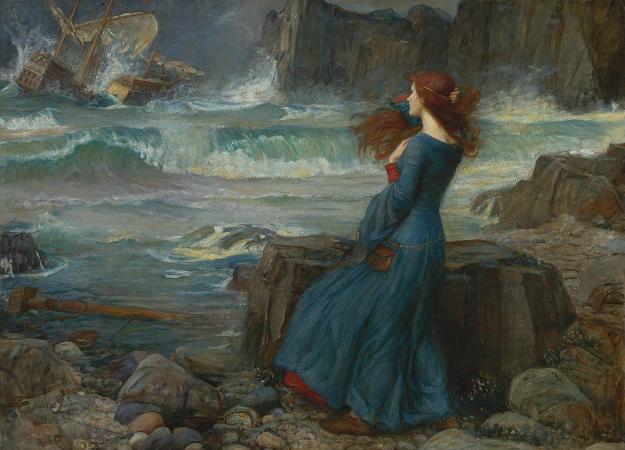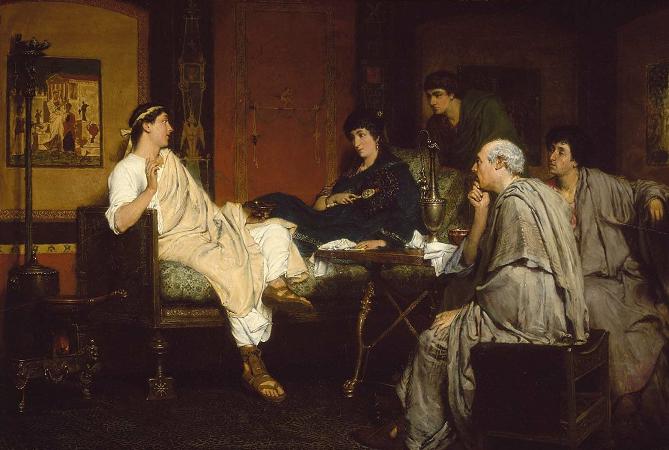Lawrence Alma-Tadema (1836 - 1912). Sir Lawrence Alma-Tadema, was a Dutch painter of special British denizenship. Born in Dronrijp, the Netherlands, and trained at the Royal Academy of Antwerp, Belgium, he settled in England in 1870 and spent the rest of his life there. A classical-subject painter, he became famous for his depictions of the luxury and decadence of the Roman Empire, with languorous figures set in fabulous marbled interiors or against a backdrop of dazzling blue Mediterranean Sea and sky. Though admired during his lifetime for his draftsmanship and depictions of Classical antiquity, his work fell into disrepute after his death, and only since the 1960s has it been re-evaluated for its importance within nineteenth-century British art. Lourens Alma Tadema was born on 8 January 1836 in the village of Dronrijp in the province of Friesland in the north of the Netherlands. The surname Tadema is an old Frisian patronymic, meaning 'son of Tade', while the names Lourens and Alma came from his godfather. He was the sixth child of Pieter Jiltes Tadema, the village notary, and the third child of Hinke Dirks Brouwer. His father had three sons from a previous marriage. His parents' first child died young, and the second was Atje, Lourens' sister, for whom he had great affection. The Tadema family moved in 1838 to the nearby city of Leeuwarden, where Pieter's position as a notary would be more lucrative. His father died when Lourens was four, leaving his mother with five children: Lourens, his sister, and three boys from his father's first marriage. His mother had artistic leanings, and decided that drawing lessons should be incorporated into the children's education. He received his first art training with a local drawing master hired to teach his older half-brothers. It was intended that the boy would become a lawyer; but in 1851 at the age of fifteen he suffered a physical and mental breakdown. Diagnosed as consumptive and given only a short time to live, he was allowed to spend his remaining days at his leisure, drawing and painting. Left to his own devices he regained his health and decided to pursue a career as an artist. In 1852 he entered the Royal Academy of Antwerp in Belgium where he studied early Dutch and Flemish art, under Gustaf Wappers. During Alma-Tadema's four years as a registered student at the Academy, he won several respectable awards. Before leaving school, towards the end of 1855, he became assistant to the painter and professor Louis Jan de Taeye, whose courses in history and historical costume he had greatly enjoyed at the Academy. Although de Taeye was not an outstanding painter, Alma-Tadema respected him and became his studio assistant, working with him for three years. De Taeye introduced him to books that influenced his desire to portray Merovingian subjects early in his career. He was encouraged to depict historical accuracy in his paintings, a trait for which the artist became known. Alma-Tadema left Taeye's studio in November 1858 returning to Leeuwarden before settling in Antwerp, where he began working with the painter Baron Jan August Hendrik Leys, whose studio was one of the most highly regarded in Belgium. Under his guidance Alma-Tadema painted his first major work: The Education of the children of Clovis. This painting created a sensation among critics and artists when it was exhibited that year at the Artistic Congress in Antwerp. It is said to have laid the foundation of his fame and reputation. Alma-Tadema related that although Leys thought the completed painting better than he had expected, he was critical of the treatment of marble, which he compared to cheese. Alma-Tadema took this criticism very seriously, and it led him to improve his technique and to become the world's foremost painter of marble and variegated granite. Despite any reproaches from his master, The Education of the Children of Clovis was honorably received by critics and artists alike and was eventually purchased and subsequently given to King Leopold of Belgium. In 1860 he befriended the Anglo-Dutch Dommersen family of artists in Utrecht In 1862 he made pencil drawings of Mrs. Cornelia Dommershuizen and one of her sons Thomas Hendrik, whose brothers were the painters Pieter Cornelis Dommersen and Cornelis Christiaan Dommersen. Merovingian themes were the painter's favourite subject up to the mid-1860s. It is perhaps in this series that we find the artist moved by the deepest feeling and the strongest spirit of romance. However Merovingian subjects did not have a wide international appeal, so he switched to themes of life in ancient Egypt that were more popular. On these scenes of Frankish and Egyptian life Alma-Tadema spent great energy and much research.
more...














